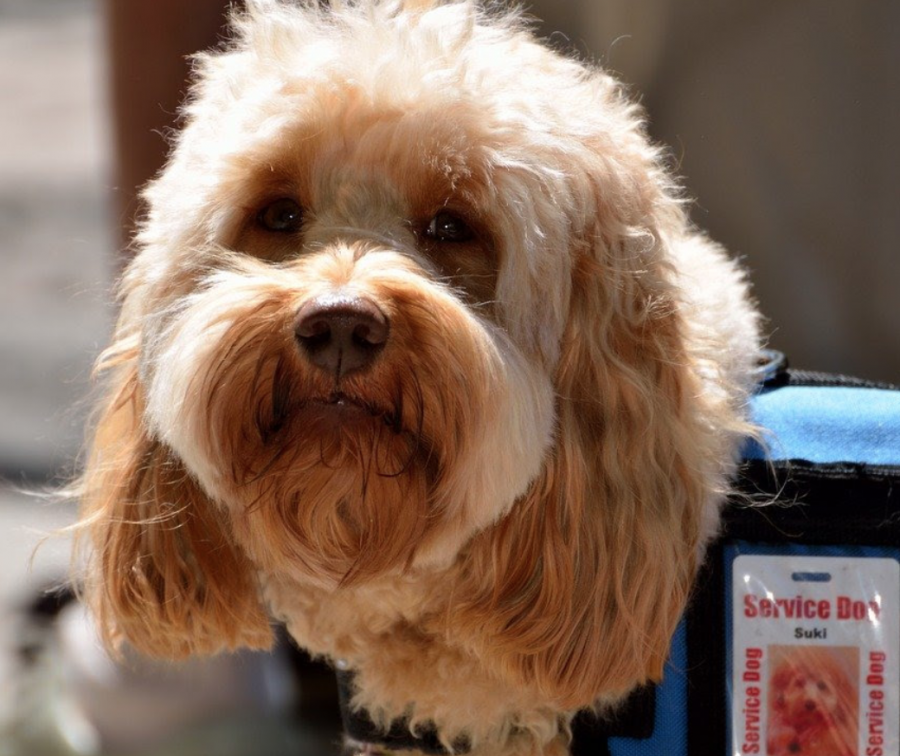Should Service Dogs be Allowed in Schools
Photo of service dog working.
Within the walls of public schools, we can find students learning, and participating. But if you listen closely, you can hear the tap of four paws on the white tile. Those four paws belong to an ADA board-certified service dog, meant to help their person with disabilities. But should service dogs be allowed in public schools? Working dogs are meant to be with their handlers everywhere, including a public learning environment.
What usually comes to mind when you think of a service dog? Is it a bright golden dog leading his visually impaired owner? Most people go right to this image, and while this is not wrong, it is also not entirely accurate. Many service dogs help with different disabilities physically or mentally. Smaller dogs are known to help with retrieving items, jumping onto countertops, barking to grab attention, and offering emotional relief to their handler. Bigger breed dogs can help balance their person, guide them, open cupboards, offer emotional relief, help if their handler falls, also with going to the restroom. As you have seen, service dogs are of crucial need to their owners. Yes, we do have special education teachers to help students in need. But what they cannot provide is the relief of the immediate attention, or the feeling of embarrassment when needing help going to the restroom. Working dogs do not judge or feel bothered, helping their handler. They live to help their human, with things they struggle with. Students of all ages can be helped with things they didn’t even know they needed help with, because of this emotional support animals are seen across the world in schools. One example is, children can be found reading to therapy animals at libraries, these students can confidently read aloud without the fear of being judged. If parents are concerned they can notify staff that a child is allergic, or frightened by the animal, and accommodations can be made.
Working dogs can be of different breeds and sizes. Common breeds are golden and labrador retrievers, german shepherd, poodle, pomeranian, and cavalier king charles spaniel. Any breed if trained from an early age can be helpful. Smaller dogs such as the pomeranian can easily, and discreetly work in classrooms. All the while being tucked under a desk or a handlers lap. Peers would not notice a small, quiet dog within a classroom. Bigger breeds may not have the advantage of being small, and can most certainly make themselves camouflaged. By hiding under a desk, or being placed in a backseat of a room. Having years of major training would assure both breed types would stay quiet, so teachers can keep teaching without worry. Purebreds are often used with this line of work, but organizations such as Merlin’s Dogs work with shelter dogs. I advocate for the rescue of animals, and this is an amazing way for second chances to happen. Dogs with the willingness to learn, taken from situations with no chance, can now live a full and happy life.
I remember overhearing 3 special education teachers discussing if a service dog would be of help to a little blind girl when I was in 5th grade. Would this make her school life easier? Will it cause a distraction in a learning environment? Could this be approved? My first thought was “if it could help then why not allow it?” The Americans with Disabilities Act (ADA) regulations, Section 504 of the Rehabilitation Act of 1973, states that a child with disabilities may take a service animal to school with them if deemed necessary. This act also works with state laws, and makes this act an important piece of evidence schools need to look at if they are having this discussion. Students should not have to go to upper level administration, to have an ongoing discussion with the Rehabilitation Act in place, because there are already laws in place to support them.
School districts, boards of education, and special education teachers seem to always be having this debate but it is really unnecessary because there are laws in place and dogs that are trained to be in the classroom. Across the country, there are service dogs in action, helping their handlers, and helping those around them. It is clear that there is evidence and laws to back up the need for service dogs. It is imperative that schools get on board and make this an easily accessible option for children with disabilities.






Adalyn • Jan 22, 2021 at 7:37 AM
i think this is 100% true 🙂